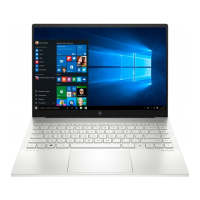
Do you have a question about the HP ENVY 14 and is the answer not in the manual?
| Bus type | DMI |
|---|---|
| Stepping | C2 |
| Tjunction | 105 °C |
| Processor cache | 3 MB |
| Processor cores | 2 |
| System bus rate | 2.5 GT/s |
| Processor family | Intel® Core™ i5 |
| Processor series | Intel Core i5-500 Mobile Series |
| Processor socket | BGA 956 |
| Processor threads | 4 |
| Processor codename | Arrandale |
| Processing Die size | 81 mm² |
| Processor frequency | 2.4 GHz |
| Processor cache type | Smart Cache |
| Processor lithography | 32 nm |
| Processor manufacturer | Intel |
| Processor front side bus | - MHz |
| PCI Express slots version | 2.0 |
| Processor boost frequency | 2.93 GHz |
| Processor operating modes | 64-bit |
| ECC supported by processor | No |
| PCI Express configurations | 1x16 |
| Thermal Design Power (TDP) | 35 W |
| CPU multiplier (bus/core ratio) | 18 |
| Maximum number of PCI Express lanes | 16 |
| Number of Processing Die Transistors | 382 M |
| Motherboard chipset | Intel® HM55 Express |
| HDD speed | 7200 RPM |
| HDD interface | SATA |
| Optical drive type | DVD Super Multi |
| Card reader integrated | Yes |
| Total storage capacity | 500 GB |
| Compatible memory cards | MMC, SD |
| Display diagonal | 14.5 \ |
| Display resolution | 1600 x 900 pixels |
| Native aspect ratio | 16:9 |
| Memory slots | 2x SO-DIMM |
| Internal memory | 4 GB |
| Internal memory type | DDR3-SDRAM |
| Maximum internal memory | 8 GB |
| Memory layout (slots x size) | 2 x 2 GB |
| Discrete graphics card model | AMD Radeon HD 5650 |
| Maximum graphics card memory | 2.714 GB |
| On-board graphics card model | Intel® HD Graphics |
| On-board graphics card base frequency | 500 MHz |
| On-board graphics card dynamic frequency (max) | 766 MHz |
| Type | PC |
| Power supply type | AC |
| Wireless technology | Wi-Fi |
| Graphics card family | AMD |
| Compliance industry standards | IEEE 802.3, IEEE 802.3u, IEEE 802.3ab |
| Cabling technology | 10/100/1000Base-T(X) |
| Networking features | Gigabit Ethernet |
| Operating system installed | Windows 7 Home Premium |
| Sustainability certificates | ENERGY STAR |
| AC adapter power | 90 W |
| Number of battery cells | 8 |
| Charging port type | DC-in jack |
| USB 2.0 ports quantity | 3 |
| Ethernet LAN (RJ-45) ports | 1 |
| VGA (D-Sub) ports quantity | 0 |
| Cable lock slot type | Kensington |
| Product color | Black |
| Country of origin | China |
| Pointing device | Touchpad |
| Processor ARK ID | 47341 |
| Processor package size | rPGA 37.5x 37.5, BGA 34x28 mm |
| Graphics & IMC lithography | 45 nm |
| Supported instruction sets | SSE4.1/4.2 |
| Intel® Turbo Boost Technology | 1.0 |
| Physical Address Extension (PAE) | 36 bit |
| Depth | 237 mm |
|---|---|
| Width | 356 mm |
| Weight | 2380 g |
| Height (rear) | 28.2 mm |
| Height (front) | 27.7 mm |
Introduces new features like Stardock software and ATI Eyefinity technology.
Guide to configuring displays and managing ATI Eyefinity technology.
Explains the enhanced audio profile and its settings.
Details on accessing the comprehensive guide for computer features and support.
How to access online help, FAQs, and troubleshooting tools.
Accessing support, downloads, and ordering parts via HP's website.
Identifies components on the top of the computer, including the TouchPad.
Explains the meaning of various indicator lights on the computer.
Details the function and operation of the power button.
Describes the function of special keys like ESC, Fn, and Windows keys.
Identifies ports and components located on the front of the computer.
Identifies ports and components located on the right side of the computer.
Identifies ports and components located on the left side of the computer.
Identifies components related to the computer's display and screen.
Identifies components located on the bottom of the computer.
Steps to establish an ISP account and connect to the Internet.
Information on connecting to wireless networks like WLAN and Bluetooth.
Guide on how to set up a new wireless local area network.
Instructions for setting up a wireless router for network access.
Advice on securing your wireless network against unauthorized access.
Explains how to use the keyboard, including action and hotkeys.
Covers setting preferences and using the TouchPad and external mice.
Step-by-step guide for battery installation and removal.
Information on identifying components and using an optional accessory battery.
Instructions for removing and installing a hard drive.
Guide for installing or upgrading RAM modules in the computer.
Steps to connect external displays using HDMI and VGA adapters.
Recommendations for keeping software and drivers up-to-date.
Proper methods for cleaning the computer display screen.
Instructions for cleaning the TouchPad and keyboard safely.
Process for creating discs to restore the computer to factory settings.
Methods for repairing or restoring the computer using recovery partitions or discs.
Guidelines and methods for backing up personal files and system settings.
How to create and use restore points to revert system changes.
Information on how to contact HP support via chat, email, or phone.
Explains the various labels on the computer and their information.
Details on the computer's power requirements and adapters.
Specifies the environmental conditions for operating and non-operating the computer.